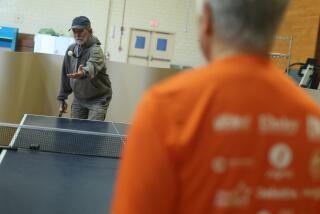Experiment’s Volunteers Tolerate Pain for Science : Medicine: The Veterans Administration study in Sepulveda is the first of its kind to look at depression and chronic discomfort.
- Share via
Apain in the back has plagued Dolores Kurzhals of Van Nuys for seven years. She can’t sit for more than 20 minutes at a time and she had to give up her job as a secretary at an engineering firm after two disk surgeries. She is now on disability and gets depressed about not being as active as she once was.
So when she heard about an experiment that studies people with chronic pain and depression, she offered to help.
“Since I can’t do much of anything else, I figure I might as well contribute to science, even if it means more pain,” Kurzhals said.
“There are very few minutes of the day when I don’t experience pain. It’s debilitating and you get depressed because you can’t do as much as you used to do.”
With about 75 other volunteers, mostly from the San Fernando Valley, she agreed to bear short doses of pain for a study being conducted at the Veterans Administration Medical Center in Sepulveda. This is the first study of its kind to look at depression and chronic pain.
“About 10% of the general population have some form of depression, but studies show that from 30 to 80% of people with chronic pain suffer depression,” said Leigh A. Messinides, who oversees the experiment as part of her doctoral research in clinical psychology at UCLA. “If someone with chronic pain has significant depression, does that cause them to be more or less sensitive to pain?”
An estimated 80 million Americans have some type of ache or pain that continues more than two years, frequently the result of injury or even damaging habits such as poor posture, but sometimes without any explanation. Most sufferers complain of back, head and neck problems. Their miseries cost businesses $70 billion a year in sick time and lost output, medical experts say.
To combat such losses, the Sepulveda VA hospital’s staff is paying volunteers $20 each to be part of an experiment that sounds macabre, but really is quite innocuous. The experiment is designed to discover whether people who experience pain as well as depression tolerate discomfort any differently from people who don’t suffer depression.
To gauge their tolerance for pain, Messinides seats her subjects in a comfortable leather chair in a small room and first uses a metal rod called a thermo-stimulator that looks like a giant car cigarette lighter. She holds it on a person’s forearm for five seconds at a time, 48 times during a 2 1/2-hour session. The area is marked with a red circle and the temperature of the thermo-stimulator goes up to 123 degrees, which is about the average temperature of a hot shower. The subject presses a button to rate the sensations until the heat becomes painful. The heat is far below any range that could cause blistering of the skin or sunburnlike redness.
A second experiment uses a pressure algometer, a device that resembles a big nutcracker and was made specifically for this experiment. The subject’s finger is placed in the device and weight with a force of 1,100 grams is applied between the joints of the finger until it reaches an intolerable level. This experiment usually leaves a temporary indentation on the top of the finger. The sensation is similar to holding onto the strings of a heavy shopping bag for a long period of time.
The third part of the experiment involves a series of increasingly louder tones blasted on a set of headphones. Subjects rate five-second blasts until the noise hits an uncomfortable level.
All the experiments are approved by a veterans hospital committee that monitors studies using human subjects. The expectation that subjects have about the upcoming pain usually is worse than the pain itself.
“I really don’t like subjecting people to this,” Messinides said. “They all seem like such nice people.”
The pain experiment never gets intolerable, and subjects can stop whenever they wish, but one nurse said she was hesitant to do the experiment and refused to do it again, even to demonstrate the study for a reporter. She, like other chronic pain patients, said she struggles with bouts of depression.
“Doctors don’t routinely ask about depression,” said Dr. Bruce D. Naliboff, director of the project and chief of the Sepulveda VA hospital’s psychophysiology research. “This has direct clinical ramifications because it could be very important to assess the mood of the patient.
“The big question is, does pain cause depression or does depression cause pain?”
Scientists have two completely opposite theories: that depressed people are more sensitive to pain, or that depressed people are not sensitive to pain and will not report it. Messinides said the study could support either theory.
Naliboff works with the Encino Pain Center, one of many small private pain clinics in the area. Valley Presbyterian Hospital and Northridge Hospital Medical Center also have their own chronic pain programs.
Fifteen years ago, Ron Rozanski started the Pain Management Program at Northridge because, he said, “doctors get overwhelmed by the demands for help from a person in pain, and the trend is to treat them with narcotics. We teach people to manage pain in a different way.”
Pain programs attempt to reduce anxiety caused by the perpetual aches and help patients get restful sleep and avoid fatigue during the day without drugs, Rozanski said. But, he said, depression about the pain is the hardest hurdle to overcome.
“Even if they are fairly stable financially, chronic pain could cause them to be depressed and feeling very worthless,” Rozanski said. “The big irony is that pain patients look fine, they don’t have signs of a missing limb, so other people often think they’re faking it.”
Doctors are becoming more aware of depression and how it is linked to illnesses, Rozanski said. But he added: “It is criminal that more research like this is not being done.” He said he believes that the study will prove that depressed people with chronic pain have a higher sensitivity to pain levels.
In past published studies, the Sepulveda VA hospital’s research lab proved that people with chronic pain have a higher threshold of pain than people without chronic pain. Previous studies on pain perception in the 1950s did not use a typical person with chronic pain, but instead heavily medicated people in hospitals who had low energy levels.
This pain experiment is financed by a small part of a $60,000 federal grant to study links between physiological problems and depression. Messinides volunteers her time, and the only expense is the equipment, payment to volunteers and advertising the study.
Some people in the study are part of a control group who are neither depressed nor experiencing pain, but most of the subjects have had aching throbs or muscle spasms from six months to 12 years. The subjects are ages 21 to 65, with most in their prime working years, the 30s and 40s. Most complain of trouble in their lower back, head and neck, and a few have had bone fusion surgery to repair their backs.
Most of the depressed people with chronic pain experience anger, helplessness, fatigue, appetite changes, inability to concentrate or sleep, and wild changes in interests.
A study that could help frustrated people who hurt all the time is long overdue, said Sandy Dudzik, a group leader of a Northridge chapter of the American Chronic Pain Assn. Some members of the self-help group she started are volunteering for the study.
“It’s important to meet other people in your condition and get emotional support for your pain,” said Dudzik, whose nonprofit group meets at Northridge Hospital every other Tuesday, but is not connected with the hospital or its pain program. They discuss self-esteem problems, practice relaxation techniques and compare controversial therapies such as biofeedback.
“Before I started going to these meetings, ‘How are you?’ was such a hard question for me to answer,” said Dudzik, who realized four years ago that her back pain would haunt her for the rest of her life.
There are 523 pain association chapters nationwide. Some local ones meet in Montrose, Northridge, Panorama City, Thousand Oaks, Verdugo Hills and Westlake Village. Dudzik said the meetings helped her overcome her isolation and frustration.
“We’ve been told that the medical community will fix it and they can’t,” Dudzik said. “We end up mourning the loss of who we were 10 years ago.”
Volunteers for the study, such as Terry Kleinman of North Hollywood, learned about the chronic pain groups and hospital pain centers by coming to the Sepulveda VA hospital.
“I came at first just to earn some money. I didn’t expect to get help,” said Kleinman, who at 49 can no longer drive or make deliveries as she once did for a living. “But I got some good information to help me go on.”
Kleinman said that her anxiety about her backaches has always caused stress and that she learned to stop taking mind-altering drugs to suppress her pain.
“The problem is, if you get into thinking about yourself, you’re just going to get more depressed and feel more pain,” Kleinman said. “When I told my friends I was doing this pain study, they asked me if I was crazy. But they don’t understand that I’d like to do anything to stop this pain, anything.”
For information on local meetings, call the American Chronic Pain Assn. in Rocklin, Calif. at (916) 632-0933. For information about the veterans hospital study or to volunteer, call (818) 891-7711, ext. 7606.






